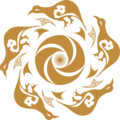In the following year, the facades of the building were finished. Bronze (brass) products were also transferred for the mausoleum, and eleven of them have survived to this day: a large cauldron, six lamps and four khalkas – a kind of hammer, placed in pairs on entrance doors of the portal and the tomb.
The lamp belongs to a certain type of objects that had a patterned base with a reservoir in the form of a cylinder or a flat ball and that originated in the Middle East in the 14th century. Sometimes these reservoirs were attached to the bases of real candlesticks of the 13th – 14th centuries. That’s why they were wrongly called “candlesticks”. But the term masradjash (“lamp”) was mentioned in the inscription on a similarly shaped base (1458 – 59) kept in the Imam Reza Museum in Mashhad. The decor of the lamp from the mausoleum of Khoja Ahmed Yasawi is made of eleven ornamental stripes.
Arabic inscriptions are written on the reservoir and on the middle part in the Thuluth script: “This is what was made by the order of His Excellency the sovereign, ruler of the wise, ruling and just poles of peace and faith Amir Timur Gurkan, may Allah keep his kingdom and glory”, and “This is what was made by the order of His Excellency the sovereign, ruler of the wise, ruling and just. Glory, and happiness, [and] power, [and] well-being, [and] peace. This is what was made by the order of His Excellency the sovereign, the ruler… Glory, [and] happiness, [and] power, [and] well-being”.
On the bottom edge of the base is engraved the inscription: “The slave Izz ad-Din [son of] Taj ad-Din Isfahani made this on the 20th day of the Blessed Ramadan of the year 799”. This inscription cannot be considered original for three reasons: 1) it is engraved (carved), while other inscriptions are encrusted with gold and silver; 2) it is not included in the decor of the lamp, but is located on a place free from ornamentation; 3) the same date of the end of the work – 20th day of Ramadan of the year 799 / June 17, 1397 – is on three lamps of the same type, which is doubtful because of their big size.
One inscription contains the name of Timur. Consequently, it was made before 1405, the year of his death. However, the question of whether the lamp was intended for the mausoleum of Ahmed Yasawi cannot be clearly answered. Indeed, the beginning of these two inscriptions: “This is what was made by the order of His Excellency…”, an odd number of cartouches with ornaments and inscriptions, filling the free space between the letters with floral ornament elements all show that this lamp was made by masters from Syria.
You can learn more about the topic in the book-album "Collection of the State Hermitage Mavarannakhr Art 8th – 15th centuries" (XV volume) from the series "Cultural Legacy of Uzbekistan in the World Collections".
The main sponsor of the project is the oilfield services company Eriell-Group.

